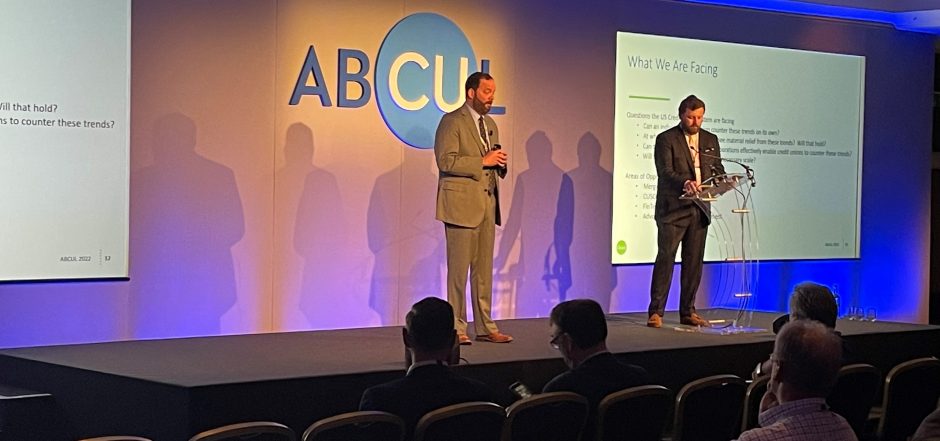Britain’s credit unions met for their annual conference in May, with Manchester’s reliably cloudy skies matching a gloomy economic outlook. Delegates were glad to be meeting in person after the pandemic, but the event – organised by the Association of British Credit Unions (Abcul) – saw them face up to the next crisis: the country’s biggest fall in living standards in 70 years.
Abcul’s new president Paul Norgrove opened the event by noting that in difficult times “credit unions always step up”. And while the wolf is hanging round the country’s door, opportunity is also knocking. Treasury minister John Glen took the podium to announce a number of regulatory changes – including a reform that will allow credit unions to offer automobile loans for the first time.
And there are other options for development coming from within the movement; one session at the conference looked at whether UK credit unions could adopt the community development credit union (CDCU) model, championed in the States by apex body Inclusiv.
Speaking at the session, Rene Vargas Martinez, director of Inclusiv’s Puerto Rican network, said CDCUs operate in underserved and underbanked communities, working with people excluded from the financial system – usually because they are immigrants, or have a bad credit score.
Related: Swoboda conference looks at credit unions and green lending
With a commitment to financial inclusion and community development, the 456 CDCUs serve 17 million people, offering “affordable financial services at good rates to people with no credit scores, no credit scores, who have not taken part in financial system“.
It also offers trusted deposit banking to people who have been suspicious of traditional banks and were used to storing their money “under the bed”: and if you win these people’s trust, they will bring others in their community along, said Mr Martinez.
This market has seen huge growth because there is no competition apart from predatory lenders – and although members have poor credit score, they pay their loans back.
“All the research we have of underserved people or people on lower tiers show us they are loyal and they will pay their loans,” added Mr Martinez. “There is some delinquency but if you offer people used to 50% interest a cheap rate, they will come back and build their credit.”
Related: Credit unions sound the alarm over cost of living crisis
Scott Butterfield, from US service organisation Your Credit Union Partner, said: “In a working class or minority area never been a better time to be a credit union or CDCU”. And as inflation bites into living standards, these communities will need help.
He advised credit unions thinking of adopting the model to “go out into community and tell a story” and appoint a “community-focused board” and design products to help local social needs; for instance, US CDCUs offer finance for survivors of domestic abuse.
Ian Brewer, from Bradford District Credit Union, discussed his efforts to put some of these ideas into practice in England. His credit union was formed in 1993 to meet a specific community need – to help council staff get credit in a recession – and in 2005 it opened its membership to all residents, later expanding to take in Kirklees and Craven.
Initiatives include Sharia-compliant lending to the Muslim community, increased payroll partnerships, and partnerships with the local council to counter loan sharks and fund a school uniform savers club.
Related: Abcul CEO announces organisation’s 2022 priorities
The uniform club used £40,000 in council funds to give each participating parent a £100 reward for regular saving towards a school uniform; for each account the council gave the credit union £40 to cover its costs and generate some income. The programme has improved the mental health and financial habits in families taking part, said Mr Brewer.
“What we do no one else can do in this neighbourhood,” he added.
“If a meaningful number of UK credit unions come together and do this, you can leverage government funding,” said Mr Butterfield. “You might take more risk but the government might support you if you can show impact.“
The session was one of many with a focus on the cost of living crisis, which will be putting credit unions under pressure as well as their members. The conference saw a lengthy panel debate on how mergers can save struggling credit unions as well as enable growth in the movement.
Consolidation is an ongoing trend in the movement, leading to fewer, bigger credit unions. Eric Broome, from Georgia’s Own Credit Union in the US, said since may 2009 his credit union had carried out nine mergers – as well as acquiring a single site bank, another growing strategy for the US sector. This has brought in $455m in assets and 69,000 people – with more on the way.
Mergers and acquisitions are “quicker than organic growth”, he said. “Organic growth is critically important,” he added, “it’s where you make your hay, but it can be tough.“
Mr Broome said there is a lot of work involved in getting a merger right, and choosing the right merger. That means considering the compatibility of systems, doing due diligence and retaining employees – which he sees as “the most important asset … with mergers, every employee comes over and we try to move them to a matched role”.
“If they do change role,” he added, “we want to upskill or reskill them and make sure they add to their portfolio of experience. Key person retention also important – keep executives and senior managers, especially as you expand outwards geographically. They have the local knowledge and contacts.”

From the UK, there was a different perspective on mergers from Kathryn Fogg of Pennine Credit Union, which has carried out several mergers – most recently last year, with Affinity Credit Union. Affinity, which had branches across the Lake District, was in trouble, she said. Having itself been created from a number of smaller credit unions, it was a mess of mismatched systems, with no one taking control and members unhappy with their service.
Affinity was a rescue mission, she said, and although it delivered little in the way of acqisition growth – a half million loan book and 1,000 members – it brought the potential for organic growth. “Since then we’ve lent a million in new cash, and added 2,000 members to the 1,000 brought over.”
The merger was hard work, she added, which involved building relationships with stakeholders, including the local authorities supporting Affinity, who initially saw Pennine as “the big bad wolf“.
“It took us six months to show us what we’d achieved,” she added, but said members are much happier with their service.
Ms Fogg warned that in the UK, credit unions are smaller, bringing more potential for personality clashes than with US mergers; and she warned there are risks in giving leadership roles to those brought over from failing credit unions. Above all, she stressed the importance of due diligence. “Your members will want to know what you are getting into.”
Failing credit unions can be turned around, however. Jonathan Moore, a building society profressional who joined Stockport Credit Union as CEO in 2019, held a side session on how the struggling credit union saw off the existential crisis of the Covid-19 pandemic.
With a weak marketing presence, unpaid staff, and inconsistent processes, Stockport CU was already in a mess, he said – so when lockdown hit it had no capacity for home-working, with its only laptop 15 years old and falling apart, and no digital offer.
The credit union’s initial response to the pandemic – a savings drive – was a mistake; the capital outflow it had feared the pandemic would provoke from members never materialised, and it was left with an expensive savings book to run.
Its next step was to launch two emergency loan schemes, including one with Stockport Council which brought some grant income, publicity, and a good relationship with the authority, which led to further projects and grants.
Mr Brewer streamlined the lending process, reducing loan decisions from a week to three days and in some cases the same day, ringing members to offer consolidation loans and bringing in digital lending. Stockport’s loan book has gone from £1m to £1.8m since September 2019 and throughout the crisis it carried on paying dividends.

Covid-19 and the cost of living crisis only add to challenges already facing the sector. In a panel session on future proofing, Eric Broome and Nickolas Kitchens from Georgia’s Own Credit Union looked at ways to adapt business models.
Again, mergers and acquisitions are important; and mean the US now has fewer than 5,000 federally insured CUs; “Scale is important. you can offer more products,” said Mr Broome.
Mergers and bank acqusitions can also give credit unions more scale to deal with its biggest challenge – the rise of fintech. “Since 2010 there have 3,5000 deals in the US for over $1tn – and the credit union share of this is low,” warned Mr Broome.
In seven years fintechs have taken 40% of auto loan marketing in the US by offering quick decisions and low rates, said Mr Kitchens – and the credit union share of the market, an important one for the sector, is falling.
No credit union can see off this challenge alone, said Mr Broome. “We have got to collaborate as a movement.”
He said credit union service organisations are an important tool, offering services such as payments and digital, while trade bodies such as CUNA offer vital advocacy. Credit unions should also work together on community engagement.
And they should also work with fintechs themselves. “They are competition and can invest in tech more quickly. We can either let them pass us by or find a way to work with them, and buy a stake in them.”
In a panel session on diversity – another pressing challenge – Rosa Franco, from Neighborhood Trust Federal Credit Union, a CDCU in upper Manhattan, NYC, presented a case study of how a credit union can drive inclusion, working with disenfranchised, low-income immigrant neighbourhoods to offer checking accounts, consumer loans, business finance and mortgages.
Led by a diverse, bilingual team, there are consolidation loans to free members from predatory lenders; credit builder loans; financial counselling workshops; and programmes to formalise members in the tax-paying economy.
Abcul’s Inclusivity Group (AIG) is looking for a way forward on diversity for the UK movement,
Its chair, Bobby Gould, said: “Credit unions are for everyone but we need to find a way to remove the barriers as democratic organisations,” adding that the AIG has drawn on work already done by the Filene Research Institute, as well as the experiences of organisations outside the movement which have been on similar journeys.
The AIG had offered a safe space, she added, with “group code of conduct as to how we work together, have difficult conversations in an environment that is open and transparent and trusted.”
A poll of conference delegates found that 44% thought Abcul is inclusive, with 49% saying maybe and 9% no. Panelist Ruksana Kauser, who sits on the AIG, said: “A few years ago I would have said no, now I would say yes.”
She added: “I don’t want just to be invited to the party, I want to dance on the table … we want to be included and get everybody’s opinion.”
The business has grown assets by 44% since 2022, with only a 1% delinquency rate, she said, and driving inclusion is a key to this success as well as a guiding purpose,
“You need to bring marginalised people into decision making process, make them feel welcome,” she added. “The board is integrated with different stakeholder and community groups and we have partnerships with local organisations.”